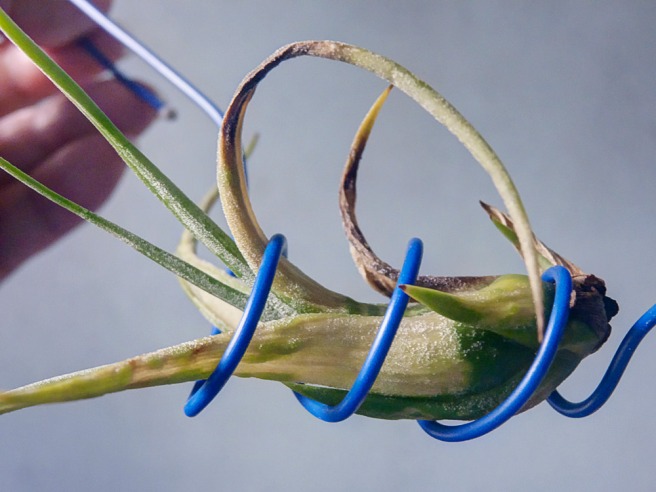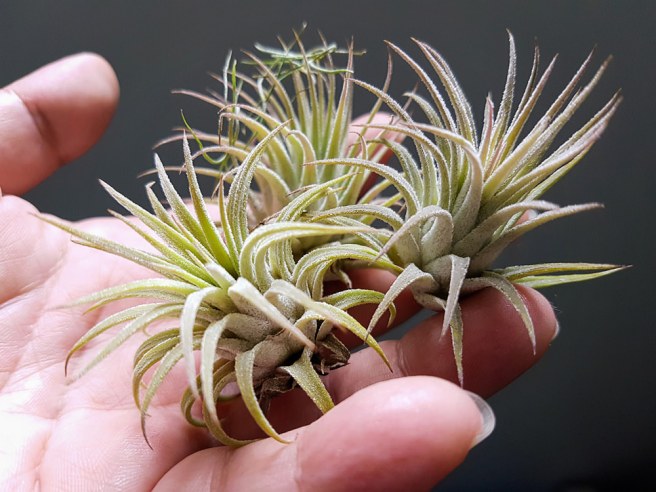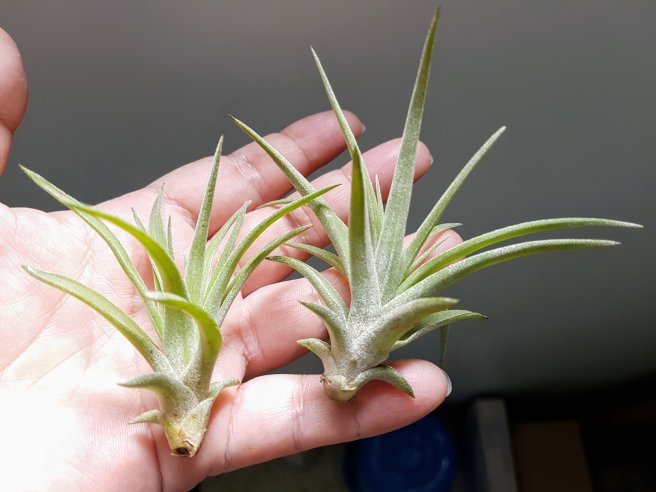Pick a Plant wrote an informational post about watering during the rainy season.
Author: Wei
Three main things
An air plant (tillandsia) needs three basic things to survive: air, water and light.
(Moving) Air
An air plant likes a breezy spot, which means no enclosed containers.

This glass hanging terrarium is pretty but it has only one opening. Air cannot move through it freely and so it is best to avoid for air plants.

This glass hanging terrarium has three openings so air can flow through it. A friend has grown air plants successfully in such a container.
Besides, enclosed containers, you should also avoid room corners where the air is stagnant. Some owners advised against putting the plants in a closed room and suggest having a fan to keep the air circulating.
Personally I don’t think there is a need to baby the air plants so much. I do keep my room closed when I go off to work in the day and my plants are still doing alright. Of course, even though the doors and windows are closed, the room is not 100% sealed. So there are gaps allowing some air circulation.
Water
A common misconception is that an air plant does not need water or an air plant is able to absorb water from the air. This is not true.
An air plant absorbs water through its leaves but it still needs to come into contact with water to do so. So do water it. (Watering is perhaps the biggest aspect of growing air plants so I may write in more detail in another post.) For now, just know that most air plants would prefer watering two or three times a week. The plant can store water in its body for a while so there is no need to water it every day.
Light
There are two kinds of light: direct and indirect sunlight.
Direct sunlight means the sun shines directly on the plant.
Indirect sunlight means that the light is filtered through another material eg. netting or a translucent material.
Depending on the type of air plant, it may prefer direct or indirect sunlight. Generally a few hours of direct sunlight a day will not kill the plant. In fact, it may be happier for it. However only a few plants can withstand a full day of the hot Singapore sun.
Some owners managed to grow air plants successfully under artificial lights. I don’t know much about this, only that you need to have light bulbs to ensure which gives off the correct light spectrum.
Fertilizer (optional)
Air plants can do quite well without fertilizer. They need so little that too much fertilizer will actually kill them. Besides, if you are watering your plants with rainwater or aquarium water, these will already provide sufficient nutrients for the plants.
Some people have tried using rose or orchid fertilizer but with only 1/8 of the recommended dosage. I don’t use fertilizer on my plants so I can’t tell you what difference it makes.
Update on Tillandsia paucifolia
Remember my sickly-looking Tillandsia paucifolia?
This is what it looks like in October 2016:

After dipping it in fungicide monthly for a few months and strictly controlling my watering, this is what it looks like in June 2017:

As you can see from the photo, some of the diseased leaves have totally died off. The yellow patches still remained but this is expected as damaged parts are unlikely to turn green again. What is encouraging is that the diseased parts are no longer spreading and there are healthy new leaves growing out from the centre.
My haul from GDO June 2017
It’s been quite a while since I’ve been to the Gardeners’ Day Out (GDO) HortPark. When I visited the event yesterday, it was more crowded than I remember. It was a last minute thing and I didn’t check if there were tillandsia stalls at the GDO. So I was quite relieved when I found Pick-A-Plant‘s stall. At least it’s not a wasted trip.

The people manning the stall did not look familiar (perhaps the owner hired new staff?). But that is not important; the important thing is that there is still a variety of air plants to choose from and they are all in good condition. The stall is also selling a variety of potted plants so maybe they are planning to diversify the business. I hope that air plants will still be their main business.
Initially I planned to buy only a few of the cheaper common species, but once again, self-control goes out of the window when faced with so many beautiful and cute air plants. I did have enough self-discipline left to limit myself to the cheapest types so I did not spend all my money at the GDO.

First, I bought a Tillandsia stricta, a new variety to add to my collection.

There were some that already bloomed but I chose one that had not bloomed yet. There is a bud in the center so it will bloom one day. Based on past experience, even though there is a bud, it may still take weeks for the flower to appear. Tillandsias really grow very slowly.

I bought two baby Tillandsia caput-medusae because I really like their strange-looking serpentine leaves. The babies are fat and cute. The moment I saw them, I went “I want! I want!” even though I already had a T. caput-medusae at home.

I also bought three Tillandsia ionantha. I really like this species. They are common so they are one of the cheaper species of air plants (although some T. ionantha varieties can be quite expensive). They are also easy to grow so they are perfect for beginners.
One of the T. ionantha came with a strand of Tillandsia usneoides (common name: Spanish moss) attached to it. It is so thin and small that I’m not sure if it will be able to survive. Time will tell, I guess.

I bought a small Tillandsia funckiana. I forget to ask the seller for the name but a T. funckiana is pretty distinctive so it should be correct. There are clumps of them available, some mounted on pieces of wood. I find the clumps intimidating so I bought only a small one to try growing first.

I also bought two baby Tillandsia velutina to replace the one that died. This time I bought two so that if one dies, I still have a backup.

Lastly, I bought a sundew from the youngest stall owner at GDO (see my previous post on GDO). Of all the carnivores plants, I like sundews the most and I bought this because of the short wide leaves, so cute! You might notice that there are two different species of sundews in the pot, which also means that it is more expensive than a pot with a single sundew. Still no regrets.
Gardeners’s Day Out on 18 Mar 2017
